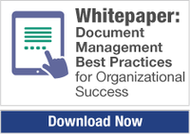
We live in an era of constant disruption, especially in the world of technology. In other words, as soon as something new comes along, something newer immediately comes along to take its place. When the standard is set, something else resets it soon after.
When we think we’ve achieved what we want, something else comes along to show us things we didn’t even know we needed. This cycle has always been at work, but never before has progress moved at such a fast pace. It’s come to the point where we often don’t know where to draw the line between progressive and superfluous.
Data management, document management, and business process automation have undergone a particularly exponential upward swing. With advancements moving at the pace they do now, we can more accurately predict the trajectory of electronic content management (ECM).
If you’re wondering why we’re using that term instead of “document management”, per usual, it’s because is actually what DMS has become. And before DMS, the handling of data and information was something else. Here’s a glimpse into the past, present, and future of DMS/ECM, and what your organization should be prepared for as a result.
The Evolution of Workflow (The Twist: It Hasn’t Been That Progressive Till the Last Decade)
- First, and for hundreds of years, we had just paper.
- In the 50s we graduated to microfilm, primarily for documenting and recording. In terms of business processes, however, paper still remained.
- Between the 60s and 80s, new IT developments saw the rise of enterprise resource planning (ERP) for data and back-end processes. Yet again, however, paper was still the primary vessel for information on a day-to-day basis.
- From the 80s through the 90s, document management systems and workflow became essential to departments that handled accounts payable, contracts management, and compliance regulations. Local area networks gave us the power to run processes through a closed cycle of specific team members within an organization.
- If the previous decades brought us from Point A to Point B, the Internet brought us to Point G. And thus we, from the early 2000s to the present, have been optimizing workflow with ECM.
Current ECM workflows have an emphasis on document-related processes. Up until now, all information technology has been mission-critical.
What Successful Companies Are Implementing Now
So what about the new technologies that make us even more connected than we already are? If your company is keeping up in today’s tech-forward landscape, chances are you’re aware of Mobile, Analytics, Cloud, and Collaborative (MACC) technologies. If you’re not aware, all you need to do is observe the daily operations of any forward-thinking company.
They’re probably doing a lot more on their phones than making calls and checking emails. They probably have applications to track results and reassess their strategy accordingly. They probably have web service applications to conduct meetings and coordinate at any time and actively collaborate on their workflows in real time. And they probably have a place to retain, manage, and automate the countless pieces of content they deal with on a day-to-day basis.
Take Note of and Prepare for These Changes
The Internet is making information a constant stream. This will no doubt affect your current workflow and business processes. Within the next five years, thanks to MACC tech advancements, new trends will emerge:
- Changes in how content is protected
- Universal online accessibility
- Collapsing hierarchies and more open forums for innovation
- More workflows being based online
- Falls in CAPEX, rises in OPEX
- More government regulation of the Cloud
To keep up with and survive these new trends, you must embrace them. There will soon be no more room for static business automation processes. Once clear lines of structure will become blurred with time. If you want to manage and leverage information assets more effectively, you have to integrate MACC technology into your DMS/ECM processes.
Drawing the Line
The best way to learn will always be looking at the organizations that successfully implement it now. There’s a reason we keep DocuVantage’s interface as customizable as it is – because we know that with the change in technology means a change in needs, as well. None of these changes will happen overnight, and there’s nothing you need to be afraid of. But it’s almost always worthwhile to catch the insights of an expert who’s learned where to draw the line between progressive and superfluous.

